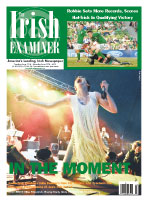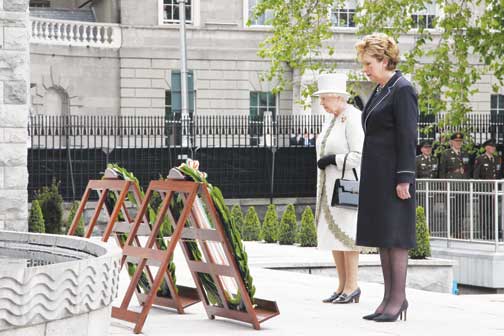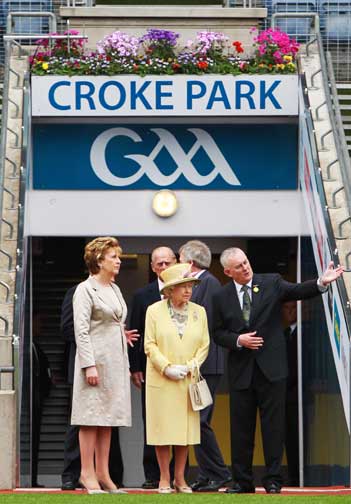


SERVICES
Tuesday May 24, 2011
"Firm Friends And Equal Partners"
Queen Elizabeth and President McAleese pause for a minute's silence after laying wreaths at the Garden of Remembrance in Dublin (Photocall) Queen Ushers In New Era In Anglo Irish RelationsThe visit of Britain's Queen Elizabeth to Ireland has been hailed as a diplomatic triumph. The four-day state visit was rich in the symbolism, and by its end the Irish public had, for the most part, taken the 85-year-old monarch to their hearts. In a week full of iconic and historic images, two stood out as particularly striking. The first was when Queen Elizabeth bowed her head in honor of those who had died fighting for Irish freedom at the Garden of Remembrance in Dublin just hours after her arrival in the country on Tuesday. She lay a wreath before the Children of Lir sculpture, took a few step backs, and bowed her head. In one simple move, she had acknowledged the legitimacy of Ireland's independence and honored the legacy of the men and women who had fought for it. The second landmark moment of the visit came as she delivered her keynote speech at a State dinner in Dublin Castle on Wednesday evening. She prefaced her speech with a few words in the Irish language which had not been in the script circulated to the media in advance. "A hUachtarain agus a chairde," she said, which means "President and friends..." The unexpected use of Irish struck a chord with the public, and seemed to surprise even her fellow diners at the top table. President Mary McAleese could be heard exclaiming "Wow!" as the Queen spoke in Irish, the words perfectly pronounced. The speech itself contained a strong message of reconciliation describing Britain and Ireland as "firm friends and equal partners". She said the two countries had experienced "more than their fair share of heartache, turbulence and loss". "To those who have suffered as a consequence of our troubled past, I extend my sincere thoughts and deep sympathy," she said. "With the benefit of historical hindsight we can all see things that we would wish had been done differently or not at all." It stopped short of an apology that some hardline republicans wanted to hear, but was the strongest expression of regret over the past that the Queen had ever made in a foreign country. "What she said about things that could have been done differently or not been done at all, I think will have spoken volumes to people in Ireland," said British Prime Minister David Cameron, who also visited Ireland for the occasion. Taoiseach Enda Kenny also thought the speech was remarkable. "I think people were very taken by the extent of her words and the clarity and ringing tone in which she said them," he said. Although details of the Queen's itinerary were well known in advance, the reaction to individual parts of the visit surpassed expectations. It's one thing to know that she was going to lay a wreath at the Garden of Remembrance - it's another to actually see it being done. The power of the symbolism resonated with the public. The trip included another wreath laying of significance, as both the Queen and President honored the thousands of Irish soldiers who died in the First World War as members of the British Army at the Islandbridge War Memorial.
The GAA President Christy Cooney and President Mary McAleese bring Queen Elizabeth II out to the pitch at Croke Park as she toured Dublin (Photocall) The Queen also visited Croke Park - the scene of the Bloody Sunday massacre in 1920 when 14 people were killed by British forces - and was given a warm welcome by GAA president Christy Cooney and other senior members of the Association. "It is in a positive spirit that we welcome your majesty and your royal highness to Croke Park," said Mr Cooney in a brief speech at the stadium, "Your presence does honor to our association, to its special place in Irish life, and to its hundreds of thousands of members. "Today will go down in the history of the Gaelic Athletic Association." While the first two days of the State visit were the most significant and symbolic, the second half of the trip allowed the Queen more time to indulge her interests and visit some of Ireland's tourist sites outside of Dublin. The royal visitors were treated to a concert featuring Riverdance, Westlife, The Chieftans, Mary Byrne and others at Dublin's new convention centre on Thursday night. A lifelong horse racing fan, she visited the National Stud, and Coolmore Stud, and also stopped at the Rock of Cashel in Co. Tipperary and visited Cork city on her final day. In Cork, she went on an unexpected walkabout to meet members of the public who had turned out in their thousands to cheer her outside the English Market in the city. The massive security operation that was in place for the trip was the largest ever mounted in the history of the State. It caused severe disruption for the public, particularly in Dublin, and also meant that people were unable to get close to the Queen. There were a number of arrests for public order offences, as hardline republican demonstrators clashed with Gardai, but overall there were few security problems during the royal visit. Another widely commented-on aspect of the visit, was the obvious rapport between Queen Elizabeth and President McAleese. The Irish President has been widely praised for the way she handled the occasion, her tone, her demeanor and how she represented Ireland. It is a fitting final chapter to her two terms at Aras an Uachtarain. |
CURRENT ISSUE

RECENT ISSUES


SYNDICATE
[What is this?]
POWERED BY

HOSTED BY

Terms of Service | Privacy Policy
Website Design By C3I







